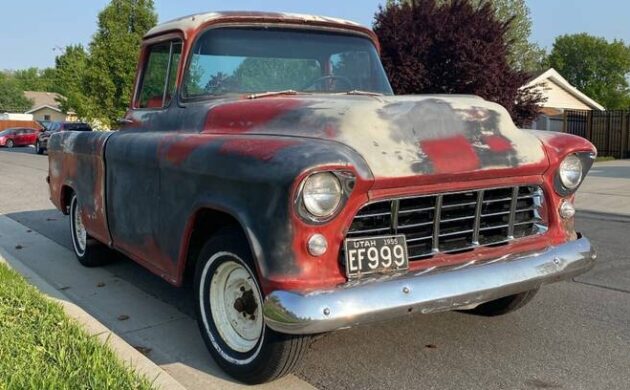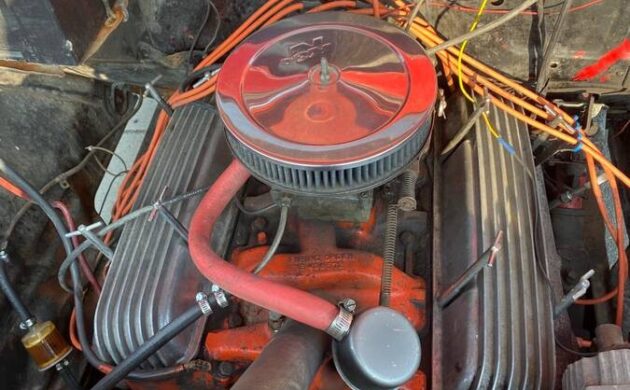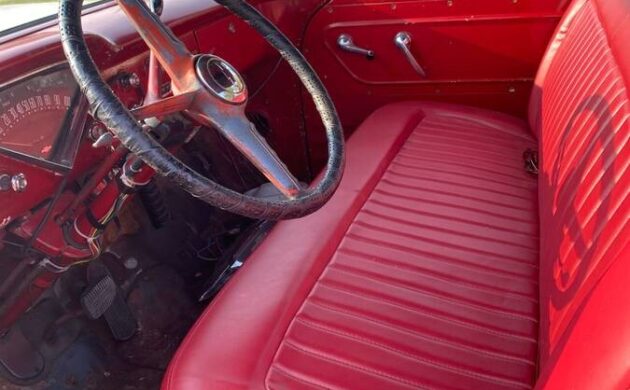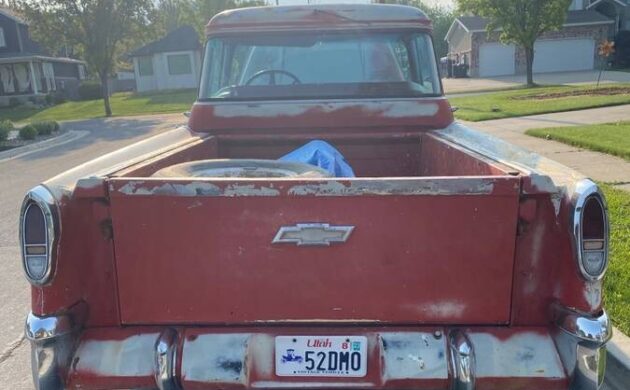The fifties were high times for GM. Every division that didn’t have a V8 engine, got one. Chevrolet delivered a knock-out punch with its ’55 passenger car redesign as well as the succeeding ’56 and ’57 models. Not to rest on that laurel, the lowly station wagon was kicked upstairs with the stylish two-door Nomad (’55-’57). Even Pontiac got in on the act with their similarly styled Safari wagon. Well, if you can gussy up a staid suburban commodity like a station wagon, how about a pickup truck? Enter the Chevrolet Cameo, such as this 1955 example. Known as the Cameo Carrier (’55-’58), it was an attempt to capitalize on the ’55 BelAir’s styling cues and apply them to a pickup – a vehicle type, that in those days, was truly utilitarian at best. We’ve covered a couple here on BF but not too many so let’s check out this Salt Lake City, Utah resident. It’s available, here on craigslist for $21,500.
According to Landers Chevrolet in Joplin, Missouri, GM stylist Chuck Jordan wanted, “radical design elements for a truck, including stylish two-tone paint, full car-style hubcaps, wide white wall tires, and — most importantly — a wide, slab-sided pickup bed that flowed back to intricate chrome tail-lights and a sculpted, sedan-style rear bumper that recalled that of the 1955 Chevrolet Bel Air”. So, popular? Well, in spite of a tariff that added 36% to the price of a base half-ton pickup, Chevy managed to sell over 5,000 Cameos (according to Hemmings) in ’55. Unfortunately, volumes fell, dramatically, in ’56 to 1,460 copies and then experienced a slight uptick to 2,240 in ’57. Halfway through model year ’58, the Cameo was discontinued after a paltry output of only 500 units.
So, pretty this one isn’t. It’s primered and multi-colored but looks basically sound. The trim appears to be missing, for the most part, but the bumpers are still attached as are the grille and the ’54 Chevy passenger car taillights. The glass looks good too so this truck seems to be a solid base for a full restoration.
Originally powered by a first-year 265 CI V8 small block engine, a later-built 327 CI mill has taken up residence in the engine room. This one is driveable but the seller doesn’t elaborate as to how well. What’s notable is that this Cameo utilizes a Hydramatic four-speed automatic transmission, not a commonly found option. Oh, and that original 265 engine? The block is included in the sale.
While not specifically stated, the interior’s bench seat appears to have been reupholstered in red vinyl at some point and it shows quite well. There’s no carpet on the floor now but that was a standard item in all Cameo trucks – an item not often found in a typical 1955 vintage pickup. The missing carpet reveals floors that are showing some scale but appear to be sound. While aftermarket gauges have been installed under the dash, it looks as if the original radio is still in place.
We have seen the values of ’50s and ’60s pickup trucks become ascendent over the last several years and while a Chevrolet Cameo is not in the mix too often, finding one is a nice departure from the regular Chevy “Task Force” truck of the era, wouldn’t you agree?








When I was a teen in the late ‘70’s, I had a friend in the neighborhood (sort of an older brother, but no relation: he had a good job, a wife, a couple small kids) and he had one of these. He was so proud of that thing, “it’s a Cameo!” I had no idea. To me, it was just a funky old pickup. Thanks for the run-down. Now I know. Pretty cool rig.
Why was a tariff applied?
I think that “tariff” is an unfortunate choice of words here- it normally implies a tax or surcharge added to the cost of goods. In this case, “upcharge” might have been more appropriate. They seem to be referring to the added cost of the “Cameo package “ over and above the cost of a standard Chevy pickup.
“Unfortunate”? That sounds like an unfortunate use of unfortunate.
JO
I feel very fortunate today and all days.
Is that a rear window wiper? That’s different. This could be a very cool ride when done, but at $20k? I understand that the value when completed would be higher, but that’s a steep buy in price for a project. What happened to those days in the ’80’s when I bought an early full size Chevrolet longbed pickup for $75.00. If project prices seem high today, how bad is it gonna be tomorrow?
I think that you may be looking at a (rubber?) radio antenna that is pushed down, making it look like a wiper arm.
The hood has two ridges. It came from a ’57.
Although I favor Chevrolet trucks over Ford for that era…I think they missed the boat with this. First, the width expansion of the pickup box should have been a no-brainer, from the same time they incorporated the fenders into the body. Anyone who’s worked with a stepside box knows how reduced is the box space. For dense loads, like dirt, or when side access to the inside of the box is required, a stepside with fenders OUTSIDE the box, makes sense. Otherwise, it’s just logical to push the outer walls to the width of the cab sides and footprint.
There’s compromises, of course. Wheel-well intrusions make the space inside irregular and give a whole set of rust-prone folds and seams. Raising the whole box, as with a stake-body flatbed, puts the load surface too high for convenience – and makes things top-heavy.
The Cameo was the worst compromise imaginable. The box was no wider – all that outside cladding, was just that, fiberglass cladding. And it wouldn’t fare well in real-world work environments. While this truck wasn’t intended for hard use, ANY pickup truck is going to face occasional hard use. That’s the point, and especially in that era. And when that happened, the fiberglass box cladding would be a weak spot.
And the high surcharge for this layout, no doubt would have kept buyers away. The appearance, while somewhat improved, wasn’t breathtaking; and the name, “Cameo” doesn’t really enhance the image of the truck in buyers’ minds. All this leads up to a sort of Rhinestone-Cowboy Cadillac – all hat, no cattle.
Nonetheless, it’s an historic milestone and worth saving. Ford, as would become the norm, was showing the way with THEIR new truck’s all-steel flush-side box. The GM designs of that era were more pleasing, even if no more practical, prior to the 1967 redesign…and, this is a tribute to how we got from where we were, Ford AA trucks, to today’s car-with-a-box-in-back.
Kudos for a thorough and well thought out post
As Poncho said “How high will it be tomorrow” ?Quien Sabe? Who Knows? This is high enough for me I would have to want it really bad to pay that for a truck that will need a total restoration. Howeve,r as we all know demand determines the price, whether you like it or not!
A labor of love. And I’m not in love. I’ll stick with my 56 F100, much more pleasing.
A little high but for a rust free Cameo, it’s not far off. (I know of o e in a junk yard and was told it was the parts truck the “one” of his good ones.(along with a 56 Suburban and a nother GMC, both with “Hydromatics”. They make my palms sweat when I see them. Behind the Cameo is just a regualr 55-56 Stepside that is rough.
The trim may be harder to find which you could maybe use to get the price down. I always liked the look of all of them and Im not hauling dirt in it after the 50k in work I’d have to do to it.
They still handle like a trash truck with the King Pins and you have to decide what value that takes off when you put a better front suspension in it. Too many decisons. I just want a 55-56 GMC stepside with just a 6 banger (with dual carbs) to tinker with during my retirement. Their bumpers and front grill are the best looking, to me.
I respectfully disagree.
My Uncle had a ’57’ Cameo, and he used it to haul numerous items during the construction of his house, and being a body man, he customized it a bit; and that included installation of a Corvette 283 with a single quad for a little ‘extra’.
At ten, in ’57’, I got to drive it on our seldom travelled street !!
Good memory, he is still living today.
That 327 and that 4 speed Hydromatic should really move this truck down the road. Hefty price but at least you can give your mig welder a rest.